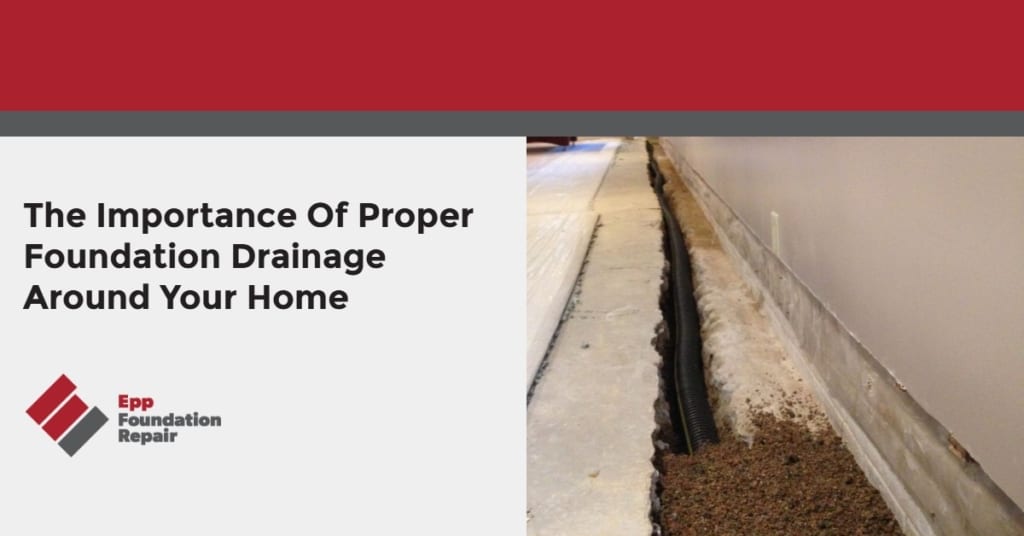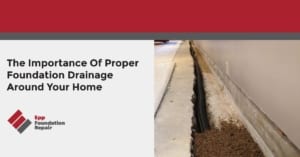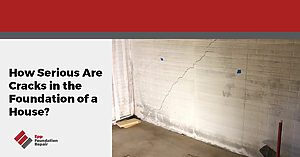Why foundation drainage is important
Residential foundation drainage systems are essential because most foundation problems are caused by water in the soil under and around the foundation.
Yes, you heard that right. Water.
Excess water in the soil under and around a foundation causes hydrostatic pressure to build up and push against the foundation walls (in other words, your basement walls) or the slab (from below).
Hydrostatic pressure against one or more foundation walls – or the slab from below – can push water through even the tiniest of hairline cracks. Hydrostatic pressure can even cause foundation cracks. Your basement wall might even start to bow inward, and if you don’t fix the problem right away, it could lead to even more severe structural damage.
Because of this, foundation drainage (i.e., groundwater control) is the key to maintaining a sound foundation. Water in the soil under and around a foundation needs a way to drain off so that hydrostatic pressure can’t form. Therefore, directing water away from your home is more important than anything else. You do not want water to pool around your foundation.
So, how do you prevent water from building up in the soil around your foundation? The key to keeping water away from a foundation is an effective foundation drainage system.
Read also: Causes of Water Seepage
Foundation drainage solutions at a glance
Proper foundation drainage ensures that water can’t build up in the soil around the foundation. We’re going to go over each one of these foundation drainage design solutions in-depth in the next section,
- Proper yard grading – Your yard should slope away from your home so that water can drain away from the foundation.
- Debris-free gutters – Clogged gutters will cause water to spill over the side of your house and into the ground around the foundation.
- Downspout extensions – Downspouts that are too short dump water next to the foundation where it will soak into the soil. Downspout extensions carry the water away from the foundation before releasing it.
- Underground downspout and sump pump discharge extension – This system transports water away from the foundation and into something called a “bubbler pot.”
- Exterior drain tile system – An exterior drain tile system installed around the outside foundation perimeter at the footer level prevents hydrostatic pressure from building up by channeling excess water away from the foundation via a perforated drainage pipe.
- Interior drain tile system – An interior drain tile system installed under the basement floor helps keep your basement dry by collecting excess water and then carrying it away from the foundation via a perforated drainage pipe.
How does foundation drainage work?
How does yard grading work?
A properly graded yard slopes away from a home’s foundation and prevents water from pooling near the foundation and sinking into the soil. Ideally, every single drop of water that falls within 10 feet of your home should flow away from it. That should be the goal.
The slope away from your home should be about 1 inch per foot. If you hold a 4-foot level against the side of your house, the end of the level touching the house will be 4-inches higher than the other end of the level.
If the soil around your home isn’t already at this pitch, you’ll need to add soil to change it. (There should be at least a few inches of the foundation showing above the ground.)
You can quickly check if you’ve done this correctly by taking the level, holding it once again against the side of the house, and lifting the other end 4 inches. If the bubble shows that it’s level, you’ve successfully regraded the soil.
If you don’t feel like doing the regrading yourself, yard drainage contractors include foundation repair professionals and landscape professionals.
How do gutters and downspouts help with foundation drainage?
Clean gutters regularly to keep them free from debris. Clogged gutters can cause rainwater to overflow and fall down the side of your home and into the soil next to the foundation.
Downspouts should direct water away from your house. If the downspout is too short or directed toward a divot in your yard, it could cause water to pool near the foundation and sink into the soil. If this is happening, install downspout extensions to channel it away from the foundation.
During the next rainstorm, go outside and perform a quick check. Ensure there’s no overflow from your gutters and that your downspouts are directing water away from your foundation.
Drain tile system
A drain tile system is a comprehensive waterproofing solution that keeps the soil around a foundation dry by collecting excess moisture and redirecting it away from the building.
There are two types of drain tile systems, exterior, and interior: An exterior drain tile system is installed outside along the foundation perimeter at the footing level. An interior drain tile system goes under the basement floor.
Both types of drain tile systems use a perforated foundation drainage pipe to collect water and then release it somewhere above ground and away from the foundation. These two foundation drains are based on the principle that water always takes the path of least resistance. In the following two sections, we’ll discuss how the two different types of drain tile systems work.
How does an exterior drain tile system work?
An exterior drain tile system (also known as a footing drain or perimeter drain) involves installing a perforated foundation drainage pipe around the foundation at the level of the footer. (In an existing home, this means excavation down to the footer. So, this isn’t exactly a DIY project.)
The installation process in an existing home is as follows:
- The foundation repair contractor excavates down to the footer and digs a trench alongside it. (The contractor might also dig a sump pit if a sump pump is necessary.)
- The contractor places the perforated pipe into the trench and then covers it with drainage gravel and a special fabric to keep soil out of the pipe.
- Finally, the contractor replaces the excavated soil.
The exterior foundation drain system will now collect excess water and direct it away from the foundation either via gravity or by collecting it in a sump pit and then expelling it via a sump pump.
Also check our blog about vapor barrier basement.
How does an interior drain tile system work?
An interior drain tile system is a basement drainage solution that goes beneath the slab (i.e., the basement floor), and this means using a jackhammer to break up the floor. (Again, not a DIY project.)
Installing an interior drain tile system can be summed as follows:
- The repair contractor uses a jackhammer to break up the basement floor.
- The contractor digs a trench around the basement’s inside perimeter. (The contractor might install a sump pit as well if a sump pump will be necessary to remove the water.)
- The perforated foundation drainage pipe is placed into the pit and covered with drainage gravel.
- The contractor replaces the basement floor.
The interior foundation drain system will now collect excess water under the basement floor and direct it away from the foundation.
Note that an interior drain tile system is not the same as a basement drain in the floor. A basement floor drain simply removes water that overflows out of your laundry machine, etc. You can think of an interior drain tile system as an interior French drain.
For more detailed information about drain tile systems, see How Does A Drain Tile System Work?
How does an underground downspout and sump pump discharge extension work?
This foundation drainage solution transports water away from the foundation and into something called a “bubbler pot.” After pressure builds in the bubbler pot, the lid opens and distributes water evenly across your yard. Here’s how it works:
- Water from your downspout falls into a PVC pipe that connects to the bubbler pot located about 10 feet away from your foundation.
- As the water flows into the bubbler pot, pressure builds, and eventually, the lid raises and distributes the water evenly across your yard.
- After the bubbler pot releases the water, the top drops back down so that dirt and grass can’t get in.
Bubbler pots are usually green, less than 12 inches wide, and sit level with the ground. Therefore, they’re virtually invisible and only pop up when they have water to release.
Is you were ever wondering how to divert rainwater away from a house, this is it. There’s also no long downspout to trip over. Other names for this foundation drainage solution include pop-up drain and gutter drain.
Since water causes most foundation problems, foundation drainage is critical to avoid damage caused by hydrostatic pressure. Fortunately, foundation drainage systems today control groundwater moisture by collecting it and then moving it away from your home.
Learn more about: How to repair a wet basement?
If you have a wet basement or you’ve noticed cracks in your foundation – and you live in Lincoln, Omaha, Kearney, Nebraska, Missouri, Iowa and parts of Northeastern Kansas and nearby areas – contact us today for an estimate.







